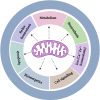Mitochondrial metabolic determinants of multiple myeloma growth, survival, and therapy efficacy
- PMID: 36185202
- PMCID: PMC9523312
- DOI: 10.3389/fonc.2022.1000106
Mitochondrial metabolic determinants of multiple myeloma growth, survival, and therapy efficacy
Abstract
Multiple myeloma (MM) is a plasma cell dyscrasia characterized by the clonal proliferation of antibody producing plasma cells. Despite the use of next generation proteasome inhibitors (PI), immunomodulatory agents (IMiDs) and immunotherapy, the development of therapy refractory disease is common, with approximately 20% of MM patients succumbing to aggressive treatment-refractory disease within 2 years of diagnosis. A large emphasis is placed on understanding inter/intra-tumoral genetic, epigenetic and transcriptomic changes contributing to relapsed/refractory disease, however, the contribution of cellular metabolism and intrinsic/extrinsic metabolites to therapy sensitivity and resistance mechanisms is less well understood. Cancer cells depend on specific metabolites for bioenergetics, duplication of biomass and redox homeostasis for growth, proliferation, and survival. Cancer therapy, importantly, largely relies on targeting cellular growth, proliferation, and survival. Thus, understanding the metabolic changes intersecting with a drug's mechanism of action can inform us of methods to elicit deeper responses and prevent acquired resistance. Knowledge of the Warburg effect and elevated aerobic glycolysis in cancer cells, including MM, has allowed us to capitalize on this phenomenon for diagnostics and prognostics. The demonstration that mitochondria play critical roles in cancer development, progression, and therapy sensitivity despite the inherent preference of cancer cells to engage aerobic glycolysis has re-invigorated deeper inquiry into how mitochondrial metabolism regulates tumor biology and therapy efficacy. Mitochondria are the sole source for coupled respiration mediated ATP synthesis and a key source for the anabolic synthesis of amino acids and reducing equivalents. Beyond their core metabolic activities, mitochondria facilitate apoptotic cell death, impact the activation of the cytosolic integrated response to stress, and through nuclear and cytosolic retrograde crosstalk maintain cell fitness and survival. Here, we hope to shed light on key mitochondrial functions that shape MM development and therapy sensitivity.
Keywords: B cell; metabolism; mitochondria; multiple myeloma; therapy.
Copyright © 2022 Nair, Gupta and Shanmugam.
Conflict of interest statement
The authors declare that the research was conducted in the absence of any commercial or financial relationships that could be construed as a potential conflict of interest.
Figures





References
-
- Cilta-cel OK’d for multiple myeloma. Cancer Discovery (2022) 12(5):1176. doi: 10.1158/2159-8290.CD-NB2022-0019 - DOI - PubMed
Publication types
Grants and funding
LinkOut - more resources
Full Text Sources
Other Literature Sources
Research Materials
Miscellaneous

